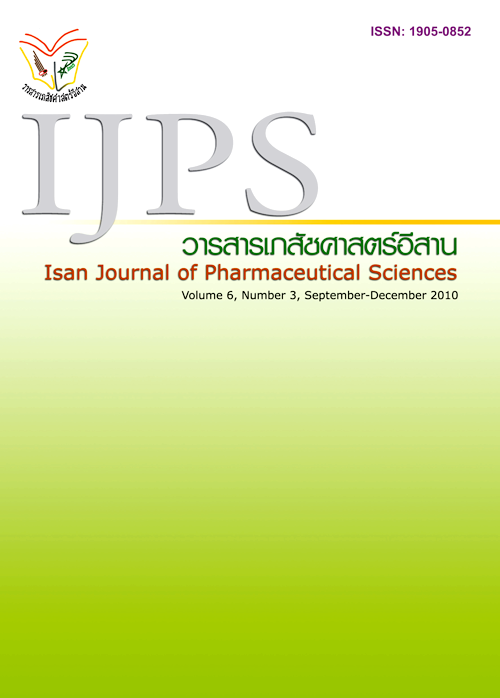The Empirical Implementation of Customer Relationship Management on Customer Satisfaction in Health Product Business: A Case of Small & Medium Enterprise in Thailand
Main Article Content
Abstract
Currently, customer relationship management (CRM) is one of the most effective customer oriented
business strategies to strengthen relationship between customers and companies. To achieve that relationship, customer satisfaction is the initial outcome of CRM. Not only service market, but health product business is also a candidate to use CRM as a business driver. Health products are popular and the trend of sale is growing up day by day. The objectives of this study were to explore the empirical implementation of CRM in health product business and to identify the tactical approaches of CRM to achieve customer satisfaction. Literatures were reviewed and expert interviews were performed to get the initial CRM conceptual framework. Payne and Frowûs framework was a theoretical guide. A new company, namely Greenie Health (Thailand), was established. Products, sold in the company, were focused on health products. The way of implementing and running the company was strictly complied with the five processes of Payne and Frowûs framework. Strategy development and value creation were established. Multichannel integration was executed and marketing activities, such as newsletter, seminar, and call center, were directed to the Greenie member and focused on key values of company, product benefits, and member benefits as well as rewards. Information management had been created and operated to support CRM execution. Lastly, performance assessment was evaluated to ensure the implementation in line with the plan. Participant observation and customer interviews, to understand customer insight, were performed. The results showed that the key drivers to enhance customer satisfaction were perceived quality of the product value, effective communication in multichannel integration, loyalty campaign - such as seminar or workshop, and special service. Attractive contact point was face-to-face contact, including booth exhibition, workshop, shop and sales force. To accomplish successful CRM implementation, the company must start with strategy development and keep focusing on value. Nevertheless, Intervention period and budget or business investment, especially in small and medium enterprise, were the constraints in this study. In practice, other marketing strategies should be run parallel with CRM to synergize and enhance business outcomes.
Article Details
In the case that some parts are used by others The author must Confirm that obtaining permission to use some of the original authors. And must attach evidence That the permission has been included
References
Boothe, Doug. (2002). CBI’s 5th Original Forum on Customer Relationship Management (CRM) for the Pharmaceutical Industry.
Bhalla, G., et al. (2004). Customer relationship management and networked healthcare in the pharmaceutical industry. International Journal of Medical Marketing, 4(4), 370-379.
Blumert, M. & Liu, J. (2003). Jiaogulan China’s “Immortality” Herb. Torchlight Publishing, Inc. Chan, J. O. (2005). Toward a unified view of customer relationship management. Journal of American Academy of Business, 6(1), 32-38.
Chen, I. & Popovich, K. (2003). Understanding customer relationship management (CRM) People, process and technology. Business Process Management Journal, 9(5), 672-688.
Cunningham, C., Song, I., & Chen, P. P. (2006). Data warehouse design to support customer relationship management analyses. Journal of Database Management, 17(2), 62-84.
Fayerman, M. (2002). Customer relationship management. New Directions for Institutional Research, 113 (spring), 57-67.
Hallowell R. (1996). The Relationships of Customer Satisfaction, Customer Loyalty, and Profitability: an Empirical Study. International Journal of Service Industry Management, 7 (4), 27-42.
Hong, S. C. & Goo, J. (2004). A causal model of customer loyalty in professional service firms: an empirical study. International Journal of Management, 21(4), 531-540.
Javalgi, R. G., Martin, C. L., & Young, R. B. (2006). Marketing research, market orientation and customer relationship management: A framework and implications for service providers. Journal of Services Marketing,20(1), 12-23.
Kale, S. H. (2004). CRM failure and the seven deadly sins. Marketing Management, 13 (September-October), 42-46.
Kim, J., Suh, E., & Hwang, H. (2003). A model for evaluating the effectiveness of CRM using the balanced scorecard. Journal of Interactive Marketing, 17(2), 5-19.
Kotler, Philip. (1997). Marketing Management. New Jersey: Prentice-Hall International. Kotler, P., Jain, Dipak C. & Maesincee, Suvit. (2002).
Marketing Moves: A New Approach to Profits, Growth, and Renewal. Boston, Harvard Business School. Ling, R. & Yen, D. C. (2001). Customer relationship management: an analysis framework and implementation strategies. Journal of Computer Information Systems, 41(3), 82-97.
Ngai, E. W. T. (2005). Customer relationship management research (1992-2002): An academic literature review and classification. Marketing Intelligence & Planning, 23(6),582-605.
Osarenkhoe, A. & Bennani, A. E. (2007). An exploratory study of implementation of customer relationship management strategy. Business Process Management Journal,13(1), 139-164.
Peelen, E. (2005). Customer Relationship Management. Harlow: Pearson Education Limited. Parvatiyar, A. & Sheth, J. N. (2001) Customer relationship management: Emerging practice, process, and discipline. Journal of Economic and Social Research, 3(2), 1-34.
Payne, A., & Frow, P. (2005). A Strategic Framework for Customer Relationship Management. Journal of Marketing, 69(October), 167-176.


